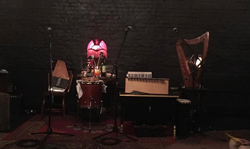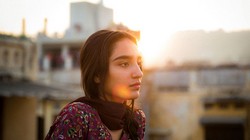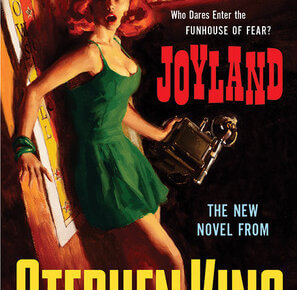Ghost Quartet is a delightfully bizarre gem of a show, small and intimate, performed by just four cast members in a black-box theatre seating just 63 audience members.
Currently in the midst of a five-week off-Broadway run at the New York Theatre Workshop’s NYTW Next Door location, the run sold out in 29 minutes flat – and I was lucky enough to be able to see it twice.
Written and composed by The Great Comet’s Dave Malloy, the show is dense and lyric-heavy, inspired by dozens of stories that came before it – including an Edgar Allan Poe tale, the Arabian Nights stories, a variety of religious theories, and an urban legend about a woman who grinned up at an unluckily-timed photographer seconds before she was hit by a subway train.
The plot itself spans seven hundred years and several generations, but also takes place directly in the moment.
Basically, very little makes sense, time does not exist within the boundaries of the production, and every actor is playing half a dozen characters, while also playing themselves.
Having seen the live show twice now, I memorized the cast album. And still, only about 80 percent of it makes sense to me.
However, for those willing to pay attention to every word, something resembling a coherent plot emerges.
Brittain Ashford primarily plays the character of Rose, a spurned young woman whose desire for revenge against her cheating boyfriend and the sister he cheated on her with sets everything in motion; Gelsey Bell primarily plays the sister, Pearl, and also performs as a delightfully psychotic Lady Usher.
Malloy himself plays that cheating boyfriend, an astronomer; he also plays a Metropolitan Transportation Authority (MTA) subway driver and a distraught father and a variety of other, smaller characters.
Brent Arnold plays a talking bear that promises Rose revenge, and also plays a vengeful shah and a disgruntled son. Overall, though, it is hard to assign each actor a role, since they play so many characters throughout the show’s 100-minute run time.
Each actor also plays a variety of instruments, and in two scenes, the audience is also made a part of the music, as instruments are passed out.
With music that ranges between every genre, the score is just as tricky and complex as the plot.
The cast members–who were all a part of the show’s conception– have been with it since the beginning.
They all deftly handle their duties, playing instruments including the Celtic harp, the cello, the erhu, the accordion, the piano, and half a dozen others.
Ultimately, the best and most obvious instrumental win is the voices of the actors themselves.
Each have a distinct vocal sound, from Ashford’s heartbreaking solos to Bell’s horrific, yet beautiful, high notes (particularly terrifying in the scarily-themed third act, which is presented in near pitch-black.)
Malloy and Arnold provide a gravelly background, and the four actors work so well together that it’s plain that the roles were written just for them.
Ashford is particularly mesmerizing, leaving every emotion on the stage and taking the audience on an emotional rollercoaster during her eight-minute solo towards the end of the show.
In other scenes, she is furious; in others, she is picture of innocence as she plays an eight-year-old.
She also plays several instruments throughout, proving herself a wonderful multitasker.
Every emotion feels supremely real, especially as she wipes away tears or turns away, scorned; in a cast of standouts, Ashford is a star.
Also wonderful is Bell, especially in a slow, sad number called “Tango Dancer” where the character morosely reflects on her life.
Playing the semi-immortal Scheherazade (from the Arabian Nights stories), she tells the audience of sadness and memory, not even relying on a microphone.
In other scenes, she plays a dark and psychotic Lady Usher (of the Edgar Allan Poe story); in others, she’s a traitorous sister.
Like her cast mates, she plays several instruments throughout, and much like Ashford, she runs the emotional gamut, leaving the audience equal parts teary and terrified.
Malloy and Arnold are also wonderful – in a cast this small, there are no weak links. Both have smaller roles, compared to Bell and Ashford, but make the most of their characterization, and their musical talent cannot be denied.
Despite the small space, the cast makes use of the room they are offered.
Bell and Ashford dance a slow, sentimental tango together; later in the show, Ashford and Malloy have a slow waltz of their own.
In another number, whiskey is passed around, offering every audience member the chance to pour themselves a shot; extra shots are passed out by the cast members themselves.
Ghost Quartet is a lovely, odd little gem that will likely enjoy a long life in off-Broadway and regional productions.
Wonderfully weird and openly strange, it’s the perfect Halloween fare, and the live show is an experience for anyone looking for something new.
PHOTO TAKEN by Kerry Breen



